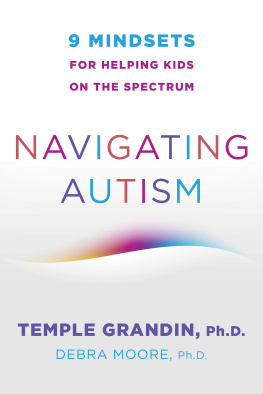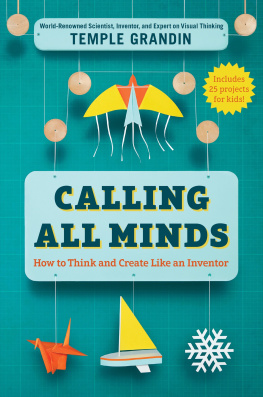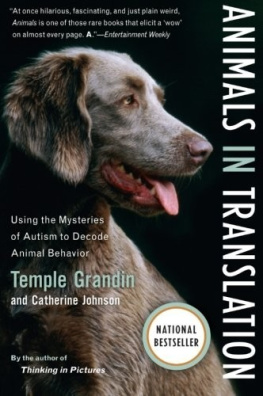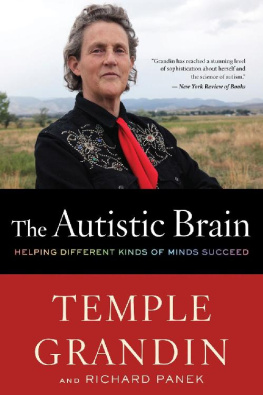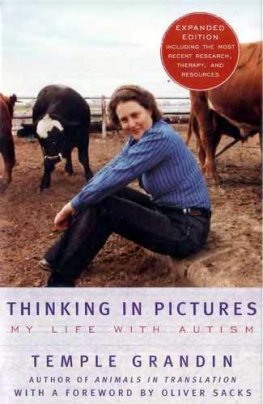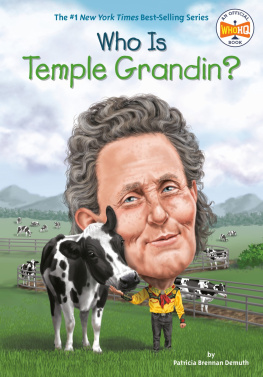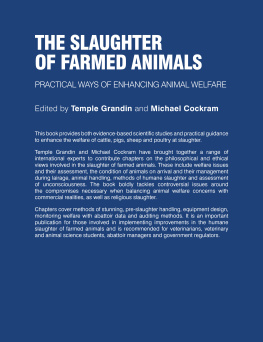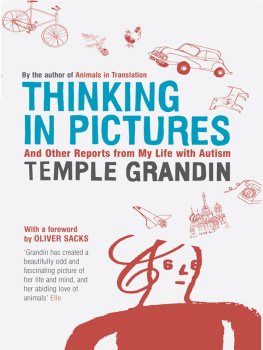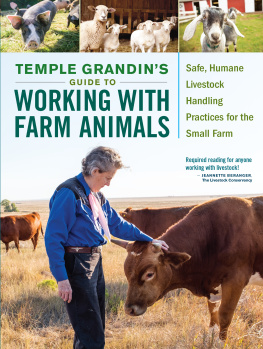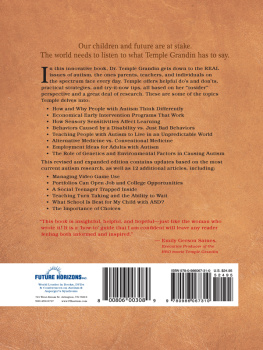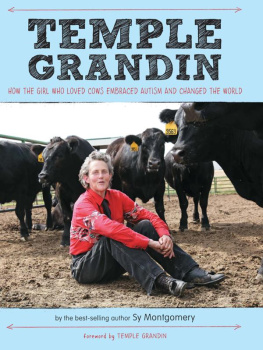Temple Grandin - Animals Make Us Human: Creating the Best Life for Animals
Here you can read online Temple Grandin - Animals Make Us Human: Creating the Best Life for Animals full text of the book (entire story) in english for free. Download pdf and epub, get meaning, cover and reviews about this ebook. year: 2009, publisher: Houghton Mifflin Harcourt, genre: Detective and thriller. Description of the work, (preface) as well as reviews are available. Best literature library LitArk.com created for fans of good reading and offers a wide selection of genres:
Romance novel
Science fiction
Adventure
Detective
Science
History
Home and family
Prose
Art
Politics
Computer
Non-fiction
Religion
Business
Children
Humor
Choose a favorite category and find really read worthwhile books. Enjoy immersion in the world of imagination, feel the emotions of the characters or learn something new for yourself, make an fascinating discovery.
- Book:Animals Make Us Human: Creating the Best Life for Animals
- Author:
- Publisher:Houghton Mifflin Harcourt
- Genre:
- Year:2009
- Rating:4 / 5
- Favourites:Add to favourites
- Your mark:
- 80
- 1
- 2
- 3
- 4
- 5
Animals Make Us Human: Creating the Best Life for Animals: summary, description and annotation
We offer to read an annotation, description, summary or preface (depends on what the author of the book "Animals Make Us Human: Creating the Best Life for Animals" wrote himself). If you haven't found the necessary information about the book — write in the comments, we will try to find it.
Animals Make Us Human: Creating the Best Life for Animals — read online for free the complete book (whole text) full work
Below is the text of the book, divided by pages. System saving the place of the last page read, allows you to conveniently read the book "Animals Make Us Human: Creating the Best Life for Animals" online for free, without having to search again every time where you left off. Put a bookmark, and you can go to the page where you finished reading at any time.
Font size:
Interval:
Bookmark:
Houghton Mifflin Harcourt BOSTON NEW YORK 2009
Copyright 2009 Temple Grandin and Catherine Johnson
ALL RIGHTS RESERVED
For information about permission to reproduce selections from this book,
write to Permissions, Houghton Mifflin Harcourt Publishing Company,
6277 Sea Harbor Drive, Orlando, Florida 32887-6777.
www.hmhbooks.com
Library of Congress Cataloging-in-Publication Data
Grandin, Temple.
Animals make us human : creating the best life for animals /
Temple Grandin & Catherine Johnson.
p. cm.
ISBN 978-0-15-101489-7
1. Emotions in animals. 2. Animal behavior.
I. Johnson, Catherine, date II. Title.
QL 785.27. G 73 2009 636.08'32dc22 2008034892
Printed in the United States of America
Book design by Robert Overholtzer
DOC 10 9 8 7 6 5 4 3 2 1
1: WHAT DO ANIMALS NEED? 1
2: A DOG'S LIFE 25
3: CATS 67
4: HORSES 105
5: COWS 137
6: PIGS 173
7: CHICKENS AND OTHER POULTRY 207
8: WILDLIFE 235
9: ZOOS 263
AFTERWORD:
Why Do I Still Work for the Industry? 295
ACKNOWLEDGMENTS 305
NOTES 308
INDEX 329
WHAT DOES AN ANIMAL NEED to have a good life?
I don't mean a good life physically. We know a lot about what kind of food, water, exercise, and veterinary care animals need to grow well and be healthy.
I mean a good mental life.
What does an animal need to be happy?
The animal welfare movement has been thinking about animals' mental welfare at least since the 1960s. That's when the British government commissioned the Brambell Report on intensive animal production. Intensive animal production means very big farms raising large numbers of animals for slaughter or egg production in very small spaces compared to traditional farms. The Brambell committee listed the five freedoms animals should have. The first three freedoms are about physical welfare, and the last two are about mental welfare:
freedom from hunger and thirst
freedom from discomfort
freedom from pain, injury, or disease
freedom to express normal behavior
freedom from fear and distress
Freedom is a confusing guide for people trying to give animals a good life. Even freedom from fear, which sounds straightforward, isn't simple or obvious. For example, zookeepers and farmers usually assume that as long as a prey species animal doesn't have any predators around, it can't be afraid. But that's not the way fear works inside the brain. If you felt fear only when you are face-to-face with the animal that's going to kill you and eat you, that would be too late. Prey species animals feel afraid when they're out in the open and exposed to potential predators. For example, a hen has to have a place to hide when she lays her eggs. It doesn't matter that she's laying her eggs on a commercial farm inside a barn that no fox will ever get into. The hen has evolved to hide when she lays her eggs. Hiding is what gives her freedom from fear, not living in a barn that keeps the foxes out. I'll talk more about this in my chapter on chickens.
The freedom to express normal behavior is even more complicated and hard to apply in the real world. In many cases, it's impossible to give a domestic or captive animal the freedom to express a normal behavior. For a dog, normal behavior is to roam many miles a day, which is illegal in most towns. Even if it's not illegal, it's dangerous. So you have to figure out substitute behaviors that keep your dog happy and stimulated.
In other cases, we don't know how to create the right living conditions because we don't know enough about what the normal behavior of a particular animal is. Cheetahs are a good example. Zookeepers tried to breed cheetahs for years with almost no success. That's a common problem in zoos. Breeding is one of the most basic and normal behaviors there is. There wouldn't be any animals or people without it. But a lot of animals living in captivity don't mate successfully because there's something wrong with their living conditions that stops them from acting naturally. The cheetah-breeding problem was finally solved in 1994, when a study of cheetahs on the Serengeti Plains came out and everyone realized male and female cheetahs didn't live together in the wild the way they did in zoos. When zoos separated the female cheetahs from the males, they turned out to be easy to breed in captivity.
Animal distress is even more mysterious. What is distress in an animal? Is it anger? Is it loneliness? Is it boredom? Is boredom a feeling? And how can you tell if an animal is lonely or bored?
Although a lot of good work has been done on mental welfare for animals, it's hard for pet owners, farmers, ranchers, and zookeepers to use it because they don't have clear guidelines. Right now, when a zoo wants to improve welfare, what usually happens is that the staff tries everything they can think of that they have the money and the personnel to implement. Mostly they focus on the animal's behavior and try to get it acting as naturally as possible.
I believe that the best way to create good living conditions for any animal, whether it's a captive animal living in a zoo, a farm animal, or a pet, is to base animal welfare programs on the core emotion systems in the brain. My theory is that the environment animals live in should activate their positive emotions as much as possible, and not activate their negative emotions any more than necessary. If we get the animal's emotions right, we will have fewer problem behaviors.
That might sound like a radical statement, but some of the research in neuroscience has been showing that emotions drive behavior, and my own thirty-five years of experience working with animals have shown me that this is true. Emotions come first. You have to go back to the brain to understand animal welfare.
Of course, usuallythough not alwaysthe more freedom you give an animal to act naturally, the better, because normal behaviors evolved to satisfy the core emotions. When a hen hides to lay her eggs, the hiding behavior turns off fear. But if you can't give an animal the freedom to act naturally, then you should think about how to satisfy the emotion that motivates the behavior by giving the animal other things to do. Focus on the emotion, not the behavior.
So far, research in animal behavior agrees with the neuroscience research on emotions. A really good study on whether animals have purely behavioral needs was done with gerbils. Gerbils love to dig and tunnel, and a lot of them develop a corner-digging stereotypy when they're around thirty days old. A stereotypy is an abnormal repetitive behavior (ARB for short), such as a lion or tiger pacing back and forth in its cage for hours on end. Pets and farm animals can develop stereotypies, too. Stereotypies are defined as abnormal behaviors that are repetitive, invariant (lions always pace the exact same path in their cages), and seemingly pointless.
An adult gerbil spends up to 30 percent of its "active time" doing stereotypic digging in the corner of its cage. That would never happen in nature, and many researchers have hypothesized that the reason captive gerbils develop stereotypic digging is that they have a biological need to dig that they can't express inside a cage.
On the other hand, in nature gerbils don't dig just to be digging. They dig to create underground tunnels and nests. Once they've hollowed out their underground home, they stop digging. Maybe what the gerbil needs is the result of the digging, not the behavior itself. A Swiss psychologist named Christoph Wiedenmayer set up an experiment to find out. He put one set of baby gerbils in a cage with dry sand they could dig in, and another set in a cage with a predug burrow system but nothing soft to dig in. The gerbils in the sand-filled box developed digging stereotypies right away, whereas none of the gerbils in the cage with the burrows did.
Next pageFont size:
Interval:
Bookmark:
Similar books «Animals Make Us Human: Creating the Best Life for Animals»
Look at similar books to Animals Make Us Human: Creating the Best Life for Animals. We have selected literature similar in name and meaning in the hope of providing readers with more options to find new, interesting, not yet read works.
Discussion, reviews of the book Animals Make Us Human: Creating the Best Life for Animals and just readers' own opinions. Leave your comments, write what you think about the work, its meaning or the main characters. Specify what exactly you liked and what you didn't like, and why you think so.




